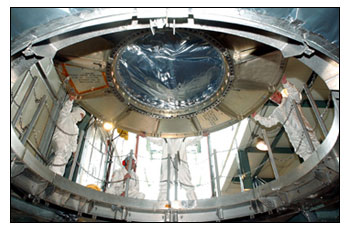ROCHESTER, N.Y., August 22 -- On August 25, NASA plans to launch the new Space Infrared Telescope Facility (SIRTF) into the first-ever Earth-trailing orbit. Using the same technology that allows firefighters to see in the dark, the observatory will provide researchers the astronomical equivalent of heat-sensing, night-vision goggles.
"The Space Infrared Telescope Facility will detect objects that have been too cold, too hidden in dust or too far away to be seen by other space observatories," said Michael Werner, the mission's project scientist at NASA's Jet Propulsion Laboratory. Researchers hope for exciting and unexpected discoveries with the additional observing power of the telescope. "You can think of this mission as lifting a cosmic veil."
PRE-LAUNCH: The Space Infrared Telescope Facility is lowered into the opening of the mobile service tower on Launch Pad 17-B, Cape Canaveral Air Force Station (Photo: NASA)
SIRTF is the final installment of NASA's Great Observatory series that includes the Hubble and Chandra telescopes. The launch has been delayed several times since its initial schedule of December 2001.
The critical infrared "eyes" of the telescope were designed in part by University of Rochester physics and astronomy professors Judith Pipher, William Forrest and Dan Watson.
According to a university press release, Forrest and Pipher were the first US astronomers to turn an infrared array toward the skies, putting the university "on the map" as home to one of the world's strongest programs in infrared astronomy. In 1983, Pipher and Forrest had mounted a prototype infrared detector onto the university telescope in the small observatory on top of the Wilmot Building on campus, taking the first-ever telescopic infrared pictures of the moon.
"That same year, NASA sent out word it was looking for scientists to help build an infrared space telescope, and Pipher and Forrest put forth their ideas based in part on the infrared technology christened on campus," the release said. "The proposal impressed NASA, and within just a few months Pipher and Forrest were evaluating and testing SIRTF's would-be eyes, and they were soon joined by Watson, a newly hired astronomer."
The Rochester contingent is part of a nationwide team of scientists from more than a dozen academic institutions and aerospace companies; the project is led by the SIRTF Science Center at the Caltech-NASA Jet Propulsion Laboratory in Pasadena, Calif.
The launch is set for 1:35 a.m. EDT, August 25. (It was most recently set for August 23.) If the weather or other problems make this impossible and the launch is called off more than 12 hours in advance, the next try would be approximately 24 hours later; if scrubbed at the last minute, the next attempt would commence approximately 48 hours after that.
SIRTF will not be launched aboard the grounded Space Shuttle fleet, but on a Delta rocket, due to its special orbital requirements. The telescope will not orbit the Earth, but will be placed in orbit around the Sun, farther into space than Earth's orbit. The telescope's mission will mark the 300th launch of the remarkably successful Delta rockets.
For more information, visit: sirtf.caltech.edu